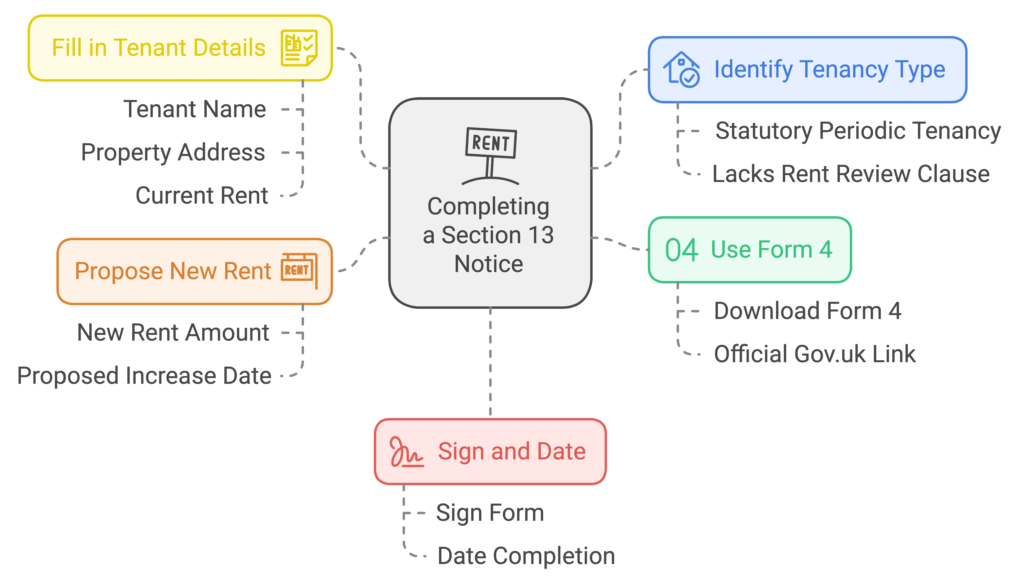Understanding the Section 13 Notice
When it comes to increasing rent during a tenancy, landlords need to navigate a variety of legal requirements. One key tool is the Section 13 notice, specifically for England. This notice allows landlords to propose a new rent for a periodic tenancy. Here’s a comprehensive guide on how to complete a Section 13 notice effectively.
What is a Section 13 Notice?
A Section 13 notice is a formal document used by landlords to propose a rent increase for tenants on periodic tenancies. This legal mechanism ensures that rent changes are communicated clearly and within legal boundaries.
- Legal framework: Governed by the Housing Act 1988.
- Usage: Applicable only when no rent review clause exists or when the tenancy is a statutory periodic tenancy.
- Form: Officially known as Form 4 in England.
For a deeper dive into the legal framework, check the UK Government’s official guidelines.
When to Use a Section 13 Notice
Landlords can use a Section 13 notice under specific conditions:
- No rent review clause: When the tenancy agreement lacks a rent review clause.
- Periodic tenancies: When the tenancy has converted to a statutory periodic tenancy after the fixed term ends.
- Annual increase limit: Rent can only be increased once every 12 months.
It’s essential to understand when and how you can apply this notice to avoid legal pitfalls.

Completing a Section 13 Notice
Here’s a step-by-step guide to completing a Section 13 notice:
- Identify tenancy type: Ensure the tenancy is either a statutory periodic tenancy or lacks a rent review clause.
- Use Form 4: Download and use the official Form 4 from Gov.uk.
- Fill in tenant details: Include the tenant’s name, property address, and current rent.
- Propose new rent: State the new rent amount and the proposed date for the increase.
- Sign and date: Sign the form and include the date it was completed.

Key Considerations Before Increasing Rent
Before deciding to increase rent, landlords should consider several factors to ensure the process is fair and legally sound.
Assessing Market Rent
Ensure the proposed rent aligns with current market rates:
- Research local rents: Compare similar properties in your area.
- Fair and realistic: The UK government advises that rent increases should be “fair and realistic.”
You can use online platforms like Rightmove and Zoopla to check local rental prices.
Communicating with Tenants
Effective communication is crucial when proposing a rent increase:
- Early engagement: Discuss potential increases with tenants well in advance.
- Sensitivity: Be mindful of tenants’ financial situations to maintain a positive relationship.
Legal Notice Periods
Adhere to legal notice periods for rent increases:
| Rent Payment Frequency | Notice Period Required |
|---|---|
| Monthly or less | One month |
| Annually | Six months |
| Quarterly | Equal to the length of the rental period (e.g., three months) |
FAQs About Rent Increases
How much notice should I give for a rent increase?
You must provide at least one month’s notice for monthly tenancies and six months for annual tenancies. For other cases, give a notice period equal to the rental period.
Can my tenant dispute the rent amount?
Yes, tenants can challenge the proposed rent by applying to a Tribunal using Form 6.
Are there restrictions on the rental amount?
If disputed, a Tribunal will assess the rent based on market rates, potentially adjusting the proposed amount.

Preparing for Tenant Reactions
Anticipating and preparing for tenant reactions can help manage the rent increase process smoothly.
Understanding Tenant Concerns
Tenants may have concerns about affordability and the fairness of the increase. Here are steps to address these concerns:
- Transparency: Clearly explain the reasons for the rent increase.
- Market justification: Show evidence of local market rates to justify the increase.
Offering Support
Consider offering support options to tenants:
- Flexible payment plans: Allow tenants to pay the increase gradually.
- Negotiation: Be open to negotiating the increase if tenants demonstrate financial hardship.
Planning for Tenant Turnover
If tenants decide to leave due to the increase:
- Evaluate costs: Consider the costs of reletting the property versus the benefits of the rent increase.
- Tenant quality: Retaining good tenants might be more valuable than a small rent increase.
Section 13 Notice: Practical Steps for Completion
Here’s a detailed look at the practical steps involved in completing a Section 13 notice.
Gathering Necessary Information
Before filling out the notice, gather the following information:
- Current rent details: Include the exact amount and payment frequency.
- New proposed rent: Decide on the new rent amount based on market research.
- Effective date: Choose a date for the new rent to take effect, ensuring it meets legal notice requirements.
Completing the Form
The official Section 13 Form 4 is straightforward but requires careful attention to detail:
- Tenant and landlord information: Fill in both parties’ names and addresses.
- Current rent: State the current rent amount and payment frequency.
- Proposed new rent: Clearly state the proposed new rent amount.
- Effective date: Include the date the new rent will start.
- Signatures: Ensure the form is signed by the landlord or their agent.
Serving the Notice
Deliver the notice to the tenant in accordance with legal requirements:
- Delivery method: Serve the notice personally, by post, or via email if agreed upon by both parties.
- Proof of delivery: Obtain proof of delivery, such as a signed receipt or recorded delivery confirmation.
Key Takeaways
Understanding and properly executing a Section 13 notice can help landlords manage rent increases legally and fairly. Here are the main points to remember:
- Legal compliance: Ensure you meet all legal requirements for rent increases.
- Fair market rates: Align proposed rents with local market conditions.
- Effective communication: Engage with tenants transparently and sensitively.
Frequently Asked Questions
How much notice should I give for a rent increase?
At least one month for monthly payments, six months for annual payments, and equivalent to the rental period for other cases.
Can my tenant dispute the rent amount?
Yes, tenants can dispute the rent increase by applying to a Tribunal.
Are there restrictions on the rental amount?
A Tribunal will assess the rent based on market rates and may adjust the proposed amount.
By following these guidelines, landlords can navigate the complexities of rent increases smoothly and maintain positive relationships with their tenants.
Summary of Key Takeaways
- Legal compliance: Adhere to all legal requirements when increasing rent.
- Market alignment: Base rent increases on local market conditions.
- Effective communication: Engage with tenants early and explain the reasons for rent increases.
- Support options: Offer flexible payment plans or negotiate increases if necessary.
- Preparation: Plan for potential tenant turnover and evaluate costs.




